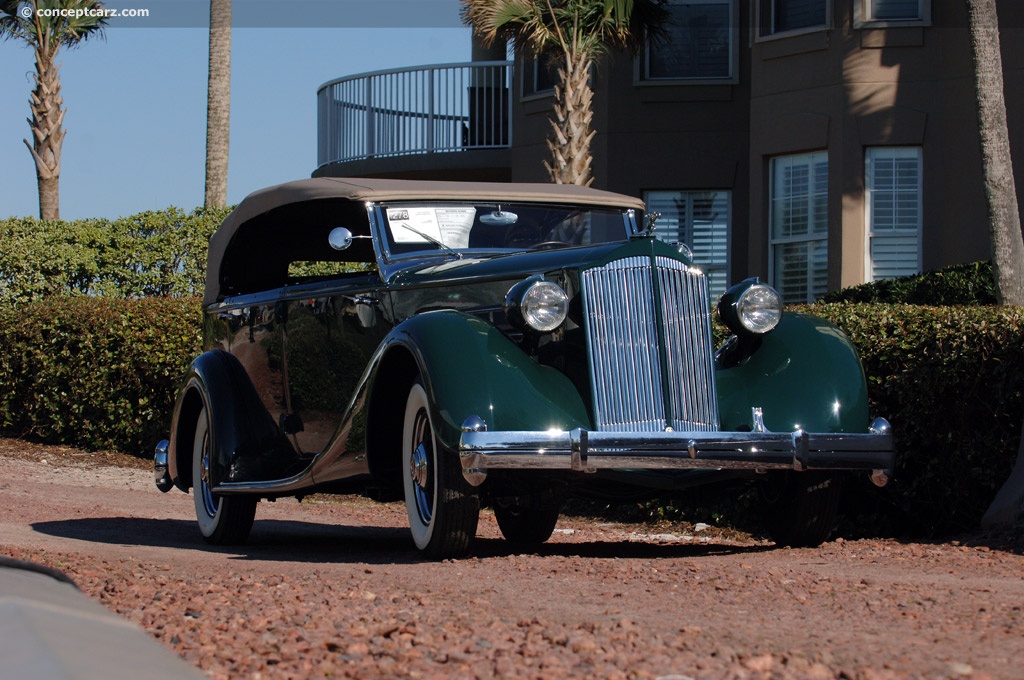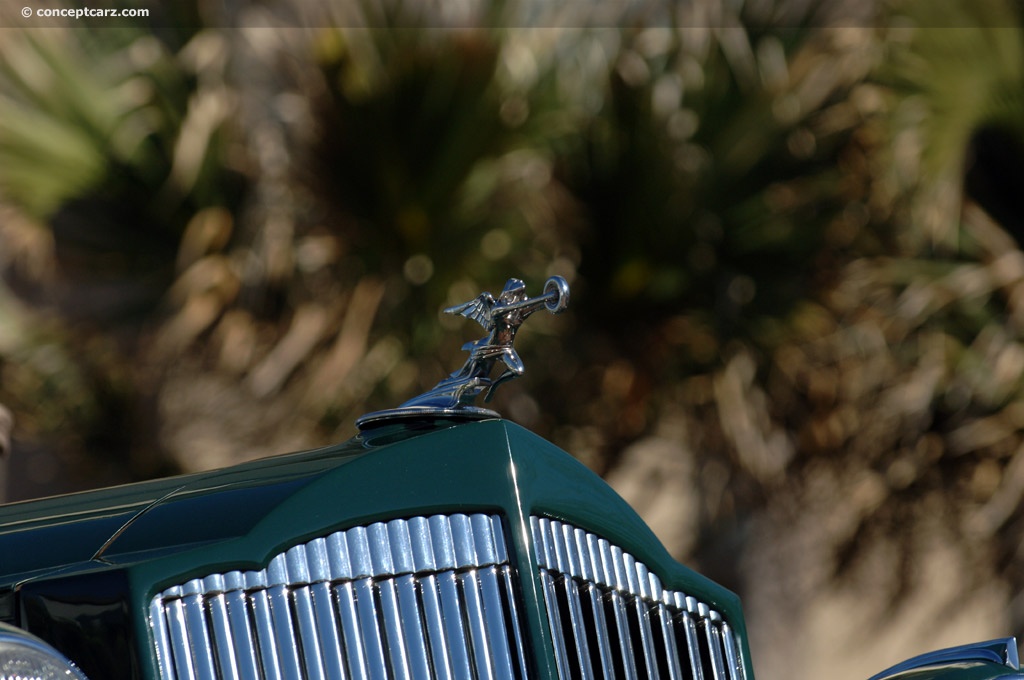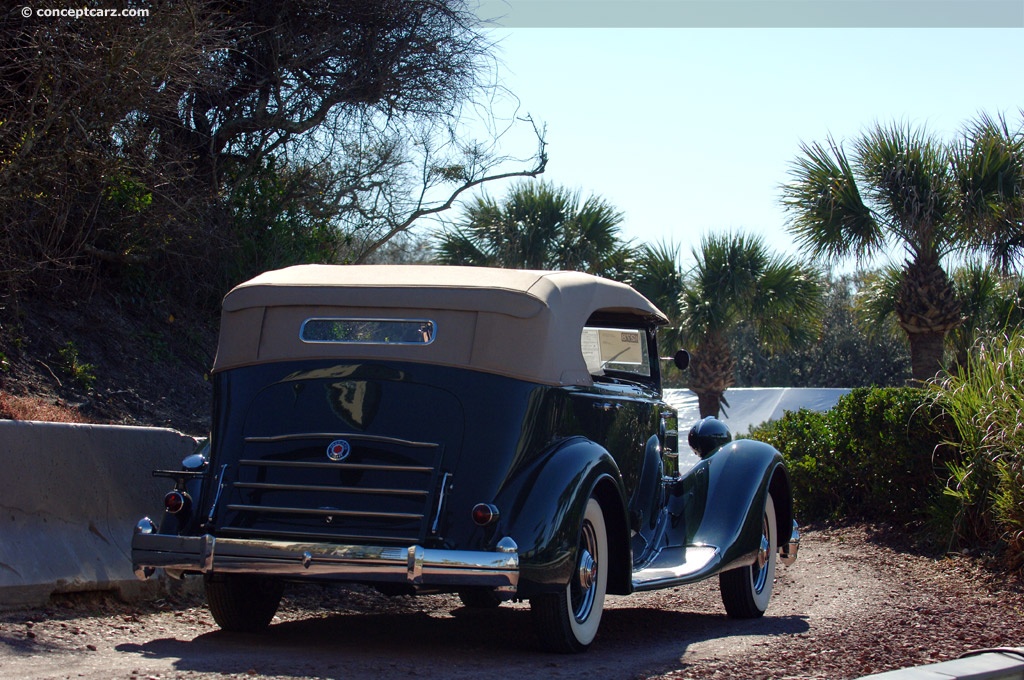The Fourteenth Series Packard model lineup included the One Twenty, Eight, Super Eight, and the Twelve. Packard followed a tradition of identifying its cars by a series designation rather than by year, with the 14th Series being introduced in August 1935 for 1936. Due to superstition, there was no 13th Series. The series was divided by wheelbase and engine, with the Eight resting on a 127-inch wheelbase platform for the 1400, a 134-inch for the 1401, and, the longest, a 139-inch wheelbase for the 1402 sedans and town cars. Only minor trim changes and styling differences distinguished the 12th Series from the 14th Series. Most examples wore standard factory coachwork while a few were ordered with custom bodies. 
Phaeton
Chassis #: 394365
View info and history
Auction entries : 6The One Twenty rested on a 120-inch wheelbase platform and was powered by an L-head straight-eight engine with a 282 cubic inch displacement and developed 120 horsepower at 3,800 RPM. It had a three-speed selective synchromesh transmission, four-wheel hydraulic brakes, and disc or steel artillery wheels. Priced at $990 to $1,400, the One Twenty was the company's most popular model, offering styling similar to its larger siblings but at a very attractive price. A total of 55,042 examples were built in 1936, a significant increase over the previous year's total of 24,995. The Super Eight consisted of the Series 1403 resting on a 132-inch wheelbase, the 1404 on a 139-inch wheelbase, and the 1405 on a 144-inch platform. The 384.4 cubic-inch straight-eight engine produced 150 horsepower at 3,200 RPM and was paired with a three-speed selective synchromesh transmission. It had mechanical brakes on four wheels and rode on welded spoke wheels. Prices ranged from around $3,000 to $6,000 and a total of 1,330 examples were built in 1936, a slight decrease from the 1,392 units built the previous year.The Twelve was the most exclusive and top-of-the-line model throughout its existence. Wheelbase sizes were similar to the Super Eight and so was the selection of factory coachwork. The 473.3 cubic-inch, 67-degree, twelve-cylinder engine produced 175 horsepower at 3,200 RPM and was paired with a three-speed transmission. Mechanical-vacuum assist brakes were at all four corners along with wire spoke wheels. Prices ranged from the low-$4,000s to the mid-$6,000s. A total of 682 examples were built in 1936, approximately 100 fewer than the previous year's total of 788. The 1936 Packard Eight
It was clear that during the mid-1930s, customers wanted the elegance, styling, and social status of the Packard automobile, yet its price tag was well out of reach for most. Packard's 'Junior' models were attainable by a much wider audience and allowed the company to recover from the crippling effects of the Great Depression. The 'Senior' models allowed customers the exclusivity and uniqueness that Packard had built its reputation. The One Twenty series easily outsold the combined production of Packard's other models, selling at approximately half of the price of the Packard Eight Sedan, the company's next most affordable model. The Packard Eight (1400) sedan was seven inches longer and its engine offered ten additional horsepower; most customers were happy to forgo these features if it meant saving $1,310. (The Packard 120 sedan was priced at $1,075 compared to the $2,385 for the Packard Eight 1400 Sedan).
Phaeton
Chassis #: 394365
View info and history
Auction entries : 6The Packard Eight was equipped with a 320 cubic-inch engine (38 cubic inches larger than the Packard One Twenty) with roller cam valve lifters, a Stromberg-Duplex carburetor, nine main bearings (compared to the five on the Packard One Twenty), and, with 6.5:1 compression, it developed 130 horsepower at 3,200 RPM. Like all other 1936 Packards, it was equipped with a three-speed selective synchromesh transmission. Mechanical brakes on four wheels kept the vehicle in the driver's control, and its 139-inch wheelbase chassis (Series 1402) rode on welded spoke wheels. This 139-inch wheelbase was shared with the Super Eight Series 1403. The front suspension was independent with coil springs, while the rear had a live axle and semi-elliptic leaf springs. The total Packard Eight production for 1936 was 3,973 examples, a significant decline from the 4,781 examples produced a year earlier. Packard's mid-level models, the Eight and Super Eight, were offered with a near-identical range of body styles, differing mostly in wheelbases and engines. It is not surprising that the less expensive EIght outsold the Super Eight three to one, considering the series was almost indistinguishable by sight. 
Phaeton
Chassis #: 394365
View info and history
Auction entries : 6The Packard Eight was offered in 17 body styles, and except for the convertible sedan, all Series 1402 (139-inch wheelbase) cars had seating for seven or eight passengers. Packard's open-bodied cars for 1936 were built by Murray Corporation of America, but they wore a Dietrich emblem, which was a legacy from designer Raymond Dietrich. Dietrich had come to Detroit from LeBaron, and established his own design business, Dietrich Inc., in partnership with Murray. Dietrich Inc. created bodies for many of the top U.S.-based automakers including Pierce-Arrow, Lincoln, Chrysler, Franklin, and Packard. By September 1930, Raymond and J.W. Murray parted ways. Raymond retained the Dietrich name and used the badge on prestige models.Body styles on the Packard Eight 1402 included a Town Car by LeBaron, a seven-passenger sedan and tourer, a limousine, a business limousine, a business sedan, and a convertible sedan. 
Phaeton
Chassis #: 394365
View info and history
Auction entries : 6As the popularity of Packard's lower-priced model increased and the demand for the top-of-the-line Twelve decreased, the company ceased production of the Twelve near the close of the 1930s and added an even lower-priced six-cylinder line. The Super Eight became the new top-of-the-line model and the One Twenty became the 'Eight.'
by Daniel Vaughan | Oct 2022

Phaeton
Chassis #: 394365
View info and history
Auction entries : 6
It was clear that during the mid-1930s, customers wanted the elegance, styling, and social status of the Packard automobile, yet its price tag was well out of reach for most. Packard's 'Junior' models were attainable by a much wider audience and allowed the company to recover from the crippling effects of the Great Depression. The 'Senior' models allowed customers the exclusivity and uniqueness that Packard had built its reputation. The One Twenty series easily outsold the combined production of Packard's other models, selling at approximately half of the price of the Packard Eight Sedan, the company's next most affordable model. The Packard Eight (1400) sedan was seven inches longer and its engine offered ten additional horsepower; most customers were happy to forgo these features if it meant saving $1,310. (The Packard 120 sedan was priced at $1,075 compared to the $2,385 for the Packard Eight 1400 Sedan).

Phaeton
Chassis #: 394365
View info and history
Auction entries : 6

Phaeton
Chassis #: 394365
View info and history
Auction entries : 6

Phaeton
Chassis #: 394365
View info and history
Auction entries : 6
by Daniel Vaughan | Oct 2022
Related Reading : Packard Eight History
The Packard Motor Company relied on making luxurious cars that were highly refined, fitted with luxurious coachwork, and powered by proven engineering. This belief had placed them among the elite in the auto industry during the early 1900s. As the world entered the Great Depression, the Packard Company was one of the few that managed to survive. In fact, they outsold all of their competitors combined.....
Continue Reading >>
Continue Reading >>
Similar Automakers
Similarly Priced Vehicles
1936 Packard Model 1402 Eight Vehicle Profiles
Recent Vehicle Additions
Performance and Specification Comparison
Price Comparison
$995 - $1,400
$2,560 - $5,240
$2,900 - $5,820
$3,690 - $4,010
$3,800 - $6,300
$4,300 - $6,400
Super Eight Specification Comparison by Year
Year
Production
Wheelbase
Engine
Prices
Related Automotive News

The Don Williams Collection of Stunning Pre-War Classics, Including 1937 Mercedes-Benz 540K, Will be Offered with No Reserve During Barrett-Jackson's 2024 Scottsdale Auction
Barrett-Jackson, The Worlds Greatest Collector Car Auctions, will offer seven stunning classic vehicles from the Don Williams Collection during the 2024 Scottsdale Auction held January 20-28 at WestWorld of Scottsdale. Each premium vehicle...

Best in Show at The Greenbrier Concours d'Elegance
The fifth annual edition of The Greenbrier Concours dElegance at Americas Resort, The Greenbrier, attracted a curated list of nearly one-hundred exquisite vehicles to the luxury mountain resort located in the Allegheny Mountains in White Sulphur...

Two Best of Show Winners : Similar Designs : Same Owner
When these two vehicles won Best of Show honors at major Concours dElegance events, they both were owned by Judge Joseph Cassini III. The green colored Chrysler 4 door Phaeton with tan convertible top wears coachwork by LeBaron. In 2012, it won the...

Eight Peter Brock designed cars on display at Palos Verdes Concours d'Elegance
Rancho Palos Verdes, CA – September 9, 2013 - Eight iconic cars designed by Grand Marshal Peter Brock will be displayed on Sunday, September 15 at the 2013 Palos Verdes Concours dElegance at the Trump National Golf Club in Rancho Palos Verdes,...

63rd Pebble Beach Concours d'Elegance Names 1934 Packard 'Best of Show'
The competition showcased 248 cars, including 48 from abroad
PEBBLE BEACH, Calif. (August 18, 2013) -- A 1934 Packard 1108 Twelve Dietrich Convertible Victoria owned by Joseph and Margie Cassini III of West Orange, New Jersey, was named Best...


























